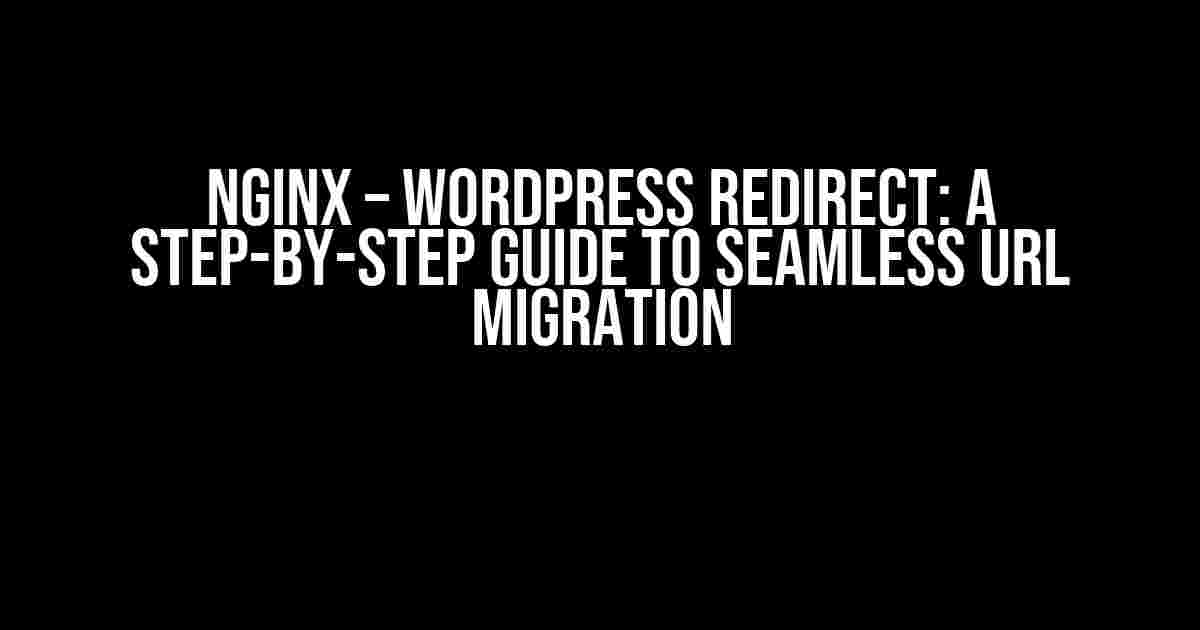Are you tired of dealing with URL redirects in WordPress? Do you want to migrate your website to a new domain or protocol without breaking a sweat? Look no further! In this comprehensive guide, we’ll show you how to set up Nginx – WordPress redirects like a pro. Buckle up, and let’s dive into the world of URL rewriting!
Why Nginx – WordPress Redirect?
Before we dive into the technicalities, let’s talk about why you need Nginx – WordPress redirects in the first place. Here are a few scenarios where redirects come in handy:
- Domain name change: You’ve rebranded your website and need to redirect traffic from the old domain to the new one.
- Protocol switch: You’re migrating from HTTP to HTTPS or vice versa, and you need to ensure a seamless transition.
- URL structure change: You’ve revamped your website’s URL structure, and you need to redirect old URLs to the new ones.
- Canonicalization: You want to specify a preferred version of your website’s URLs to avoid duplicate content issues.
How Nginx – WordPress Redirect Works
Nginx is a powerful web server that can be configured to redirect URLs using its built-in rewrite module. WordPress, on the other hand, is a popular content management system that relies on Apache or Nginx to serve its pages. When you combine Nginx with WordPress, you can create powerful redirects that take care of business.
The redirect process involves three main components:
- Request: A user requests a URL from your website.
- Nginx rewrite: Nginx receives the request and applies its rewrite rules to determine the new URL.
- WordPress routing: WordPress receives the rewritten URL and serves the corresponding page.
Setting Up Nginx – WordPress Redirect
Now that we’ve covered the basics, let’s get our hands dirty! To set up Nginx – WordPress redirects, you’ll need to:
Step 1: Configure Nginx
First, you’ll need to create a new Nginx configuration file or edit an existing one. You can do this by creating a new file in the `/etc/nginx/sites-available/` directory (the exact path may vary depending on your system).
sudo nano /etc/nginx/sites-available/example.com
In this file, add the following code:
server {
listen 80;
server_name example.com;
# Redirect from HTTP to HTTPS
return 301 https://$server_name$request_uri;
# Redirect from old domain to new domain
rewrite ^ https://newexample.com$request_uri permanent;
}
This code sets up a server block for the `example.com` domain, listens on port 80, and specifies the server name. The `return 301` statement redirects all HTTP requests to HTTPS, while the `rewrite` statement redirects the old domain to the new one.
Step 2: Activate the Nginx Configuration
To activate the new configuration file, create a symbolic link to the `sites-enabled` directory:
sudo ln -s /etc/nginx/sites-available/example.com /etc/nginx/sites-enabled/
Then, restart Nginx to apply the changes:
sudo service nginx restart
Step 3: Configure WordPress
Now that Nginx is configured, it’s time to update WordPress to work with the new redirect rules. You’ll need to update the `wp-config.php` file to specify the new domain or protocol:
define('WP_HOME', 'https://newexample.com');
define('WP_SITEURL', 'https://newexample.com');
This tells WordPress to use the new domain and protocol for all URLs.
Troubleshooting Nginx – WordPress Redirect
With great power comes great responsibility! If you’re experiencing issues with your redirects, here are some common errors to watch out for:
| Error | Description | Solution |
|---|---|---|
| Redirect loop | The redirect creates an infinite loop, causing the website to become inaccessible. | Check the Nginx configuration file for recursive redirects or incorrectly formatted rewrite rules. |
| Incomplete redirects | Only some URLs are redirected, while others remain unchanged. | Verify that the Nginx configuration file is correctly formatted and that the rewrite rules are applied correctly. |
| Canonicalization issues | The website is accessible under multiple URLs, causing duplicate content issues. | Ensure that the canonical URL is correctly specified in the WordPress configuration file or using a plugin like Yoast SEO. |
Best Practices for Nginx – WordPress Redirect
To ensure a seamless redirect experience, follow these best practices:
- Plan ahead: Test your redirects in a staging environment before applying them to your live website.
- Use 301 redirects: Permanent redirects (301) are preferred over temporary redirects (302) to avoid search engine penalties.
- Specify the correct protocol: Use the correct protocol (HTTP or HTTPS) in your rewrite rules to avoid mixed content warnings.
- Test for redirect loops: Verify that your redirects don’t create infinite loops by testing them with tools like Redirect Checker or Screaming Frog.
Conclusion
In conclusion, Nginx – WordPress redirects are a powerful tool for managing URL changes, protocol switches, and canonicalization. By following this step-by-step guide, you’ll be able to set up seamless redirects that take care of business. Remember to plan ahead, test thoroughly, and follow best practices to ensure a smooth transition for your website’s users.
With Nginx and WordPress working together in harmony, you’ll be able to:
- Improve your website’s search engine ranking
- Enhance user experience with faster redirects
- Simplify URL management with canonicalization
So, what are you waiting for? Get started with Nginx – WordPress redirects today and take your website to the next level!
Frequently Asked Questions
Nginx and WordPress redirect can be a bit tricky, but don’t worry, we’ve got you covered! Here are some frequently asked questions to help you navigate the world of redirects.
What is the purpose of redirecting a WordPress site to HTTPS using Nginx?
Redirecting a WordPress site to HTTPS using Nginx is crucial for security and SEO purposes. It ensures that all traffic to your site is encrypted, which helps to protect user data and maintain trust with your audience. Additionally, Google favors HTTPS sites in its search rankings, so making the switch can also improve your site’s visibility.
How do I redirect a WordPress site to HTTPS using Nginx?
To redirect a WordPress site to HTTPS using Nginx, you’ll need to add a few lines of code to your Nginx configuration file. One way to do this is by adding a server block that listens for port 80 requests and redirects them to port 443. Here’s an example of what the code might look like: server { listen 80; server_name example.com; return 301 https://example.com$request_uri; }
What happens if I don’t redirect my WordPress site to HTTPS?
If you don’t redirect your WordPress site to HTTPS, your users may be vulnerable to man-in-the-middle attacks, which can compromise their sensitive information. Additionally, Google Chrome will display a “not secure” warning to users visiting your site, which can harm your reputation and drive users away. And, as mentioned earlier, you may also be negatively impacted in search engine rankings.
Will redirecting my WordPress site to HTTPS affect my site’s performance?
Redirecting your WordPress site to HTTPS using Nginx can have a minor impact on your site’s performance, as it requires an additional redirect. However, the impact is usually negligible, and the benefits of HTTPS far outweigh any minor performance costs. Plus, many modern browsers and devices are optimized for HTTPS, so the impact is often imperceptible.
Can I redirect specific pages or posts to HTTPS while keeping the rest of my site on HTTP?
Yes, it is possible to redirect specific pages or posts to HTTPS while keeping the rest of your site on HTTP. You can do this by adding custom Nginx rules that target specific URLs or directories. For example, you could add a location block that only affects a specific directory or page. However, it’s generally recommended to redirect your entire site to HTTPS to ensure consistency and maximum security.


